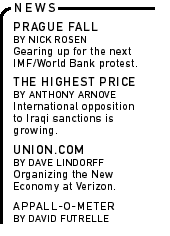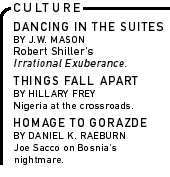 |

|

|

|

|
| |
 |
|
|
The United States has seen stock market booms before, but by most measures this one is without precedent. Since 1994 - a period of good but not spectacular growth in output and corporate profits - the broad market has tripled. Since 1989, the Nasdaq is up by more than 1,200 percent. And such aggregate numbers don't do justice to the lunacy of particular stocks. Not long ago eToys, which sold $30 million in merchandise last year and reported $30 million in losses, was worth more than Toys-R-Us, which sold $11 billion. Amazon.com, which lost $720 million last year, is still worth 10 times more than Barnes & Noble, which sold twice as many books and actually made a profit. Surely the market has lost all touch with reality. Mainstream economists, however, insist with theological certitude that markets lead to optimal outcomes (at least when free of imperfections - and no market is more perfect than the stock market). This orthodoxy prevails among the paid shills of Fidelity and CNNfn as well, so there has been no shortage of explanations for why today's stock market prices make sense: Maybe we're entering a "new era," a revolution in productivity thanks to computers and the Internet. Or maybe it's people's willingness to hold stocks that has changed. Dow 36,000, a book whose place as a bull-market footnote is probably secure, argued that people have finally discovered that stocks are really riskless over the long haul. (What needs to be explained, then, is the irrational despondence of years past, when people believed that investing in stocks might be risky.) In any case, isn't the market supposed to be a "random walk"? According to this widely held view, stock markets already incorporate all available information, so there's just no way to predict their future movements. Even Alan Greenspan claims to believe this: Sure, today's stock prices may look high, he said recently, but they reflect the informed views of "millions of intelligent investors who know the companies that they've invested in. It's the best judgment you can get." Not so, says Yale economist Robert Shiller, whose new dissection of stock market mania, Irrational Exuberance, was timed to hit store shelves almost simultaneously with April's mini-crash. It may be hard to second-guess millions of investors on tomorrow's stock movements, but over a longer period - 10 years, say - it's easy. The stock market doesn't follow a random walk at all, the book shows: Booms are predictably followed by busts. In a chart that encapsulates much of his argument, Shiller plots the stock market's price-earnings ratio (stock prices divided by corporate earnings) against the subsequent 10-year return on investments. The higher the one, the lower the other. Way out on the right side of his chart sits 1929, with by far the highest PE ratios ever (at least until the late '90s), and we all know what came after that. Peaks in PE ratios in 1901 and in the late '60s were similarly followed by sustained periods of extremely low returns. Shiller is coy about making definite predictions, but given that today's prices are well past the 1929 level, it's not hard to fill in the blanks. Elsewhere, he has suggested that to bring them back in line with historical levels, stock prices should fall by at least 60 percent. |
